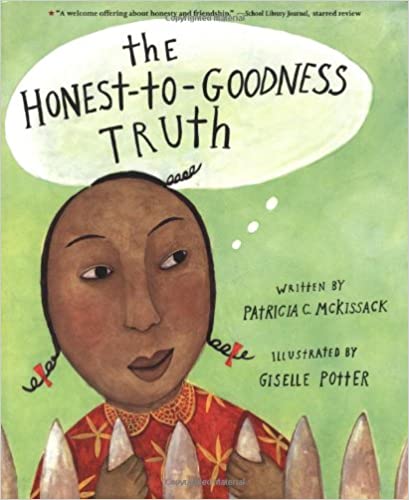Cart
local_shipping Free Standard Shipping on all orders $25+ and use Coupon Code GiftBooks15 for an additional 15% off!
The Honest-To-Goodness Truth
Author
Illustrator
Giselle Potter
Publication Date
January 01, 2003
Genre / Grade Band
Fiction / 2nd − 3rd
Language
English
Format
Picture Book

Only 4 copies currently available
Description
After promising never to lie, Libby learns that it's not always necessary to blurt out the whole truth either. Full-color illustrations.
Publication date
January 01, 2003
Genre
Fiction
ISBN-13
9780689853951
Lexile Measure
650
Guided Reading Level
O
Publisher
Atheneum Books for Young Readers
BISAC categories
JUV019000 - Juvenile Fiction | Humorous Stories
JUV039220 - Juvenile Fiction | Social Themes | Values & Virtues
JUV039220 - Juvenile Fiction | Social Themes | Values & Virtues
Library of Congress categories
African Americans
Conduct of life
Honesty
Truthfulness and falsehood
Conduct of life
Honesty
Truthfulness and falsehood
Publishers Weekly
"McKissack thoroughly examines a common childhood problem-discerning when the truth helps and when it hurts-with homespun language and accessible situations," wrote PW. "The intimate settings so integral to Potter's folk-art style provide a fitting complement to the author's cozy community." Ages 4-8. (Jan.)
School Library Journal
Starred Review
K-Gr 3-When Libby Louise's Mama tells her to "Speak the truth and shame the devil," Libby takes the advice too literally, and tells truths wherever she goes. Starting with telling her friend-in public-that there's a hole in her sock, Libby pushes honesty to the hilt both in school and out, about missed homework, embarrassing mistakes and punishments, and messy yards. Her promise to "tell the truth no matter how much it hurt" leaves a trail of wounded feelings and offended people, but Libby doesn't understand the reactions she's getting until her beloved horse is called an "old flea-ridden swayback." The language of the text conveys the flavor of African-American Southern speech patterns, using some colorful similes ("That horse is older than black pepper") but avoiding the use of dialect. The illustrations, in a faux-na f style, are done in soft tones, with browns and greens predominating, evoking the warm feeling of a small country community in which blacks and whites live, go to school, and attend Sunday school together, and everyone knows everyone else. A welcome offering about honesty and consideration.-Marian Drabkin, Richmond Public Library, CA Copyright 2000 School Library Journal, LLC Used with permission.
Publishers Weekly
"Speak the truth and shame the devil," says Libby Louise Sullivan's mother after Libby Louise tells her a fib. Her own shame far outweighs the punishment dealt out by her mother, and Libby Louise vows, "From now on, only the truth." But the girl's strict enforcement of her own rule soon lands her in deep water. She alienates a host of people: her best friend by publicly pointing out a hole in her sock; a classmate by tattling on him; and a neighbor by critiquing her garden. McKissack (Let My People Go) thoroughly examines a common childhood problem--discerning when the truth helps and when it hurts--with homespun language and accessible situations. The intimate settings so integral to Potter's (Three Cheers for Catherine the Great!) folk-art style provide a fitting complement to the author's cozy community. Her depictions of an alternately astonished and contrite Libby Louise, who winds up feeling the sting of truth herself, will likely cause readers to recall their own chagrin in similar circumstances. Ages 4-8. (Jan.) Copyright 2000 Publishers Weekly Used with permission.
School Library Journal
Starred Review
K-Gr 3-When Libby Louise's Mama tells her to "Speak the truth and shame the devil," Libby takes the advice too literally, and tells truths wherever she goes. Starting with telling her friend-in public-that there's a hole in her sock, Libby pushes honesty to the hilt both in school and out, about missed homework, embarrassing mistakes and punishments, and messy yards. Her promise to "tell the truth no matter how much it hurt" leaves a trail of wounded feelings and offended people, but Libby doesn't understand the reactions she's getting until her beloved horse is called an "old flea-ridden swayback." The language of the text conveys the flavor of African-American Southern speech patterns, using some colorful similes ("That horse is older than black pepper") but avoiding the use of dialect. The illustrations, in a faux-na f style, are done in soft tones, with browns and greens predominating, evoking the warm feeling of a small country community in which blacks and whites live, go to school, and attend Sunday school together, and everyone knows everyone else. A welcome offering about honesty and consideration.-Marian Drabkin, Richmond Public Library, CA Copyright 2000 School Library Journal, LLC Used with permission.
Golden Sower Award
-
Nominee 2002 - 2002



